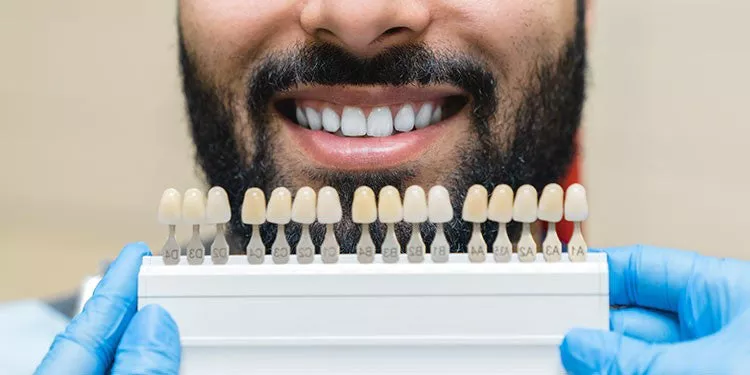For more severely crooked teeth, orthodontics may be the appropriate solution to correct your smile. But if your teeth are only slightly crooked, yellowed or stained, chipped, or misshapen, and you want to improve your smile, there are several cosmetic dentistry procedures that will give you the smile you have always wanted.
To give yourself a complete smile makeover, consider the different types of teeth veneers. A veneer is a thin, tooth-colored material that is placed on the outer surface to hide any minor imperfections to the front teeth. Veneers can improve the look of your smile and protect your teeth from bacteria getting in minor cracks or chips without using a dental crown.
If you're interested in improving your smile with veneers, the first step is scheduling a consultation with a cosmetic dentist.
If you're not ready to schedule a consultation and want to learn more, see full article, or chat with a cosmetic dentist to explore options. There are different types of veneers to consider, such as the material used, durability, and price. How much do full-mouth veneers cost per tooth? You can weigh the price difference between the various types, as well as the cost of full mouth veneers to the cost of veneers per tooth. Learn more below.
Porcelain Veneers
Pros of Porcelain Veneers
- Custom made for your mouth
- Stain-resistant
- Very strong and durable
- Smooth texture
- Very natural appearance
- Long-lasting, typically eight to 20 years
Cons of Porcelain Veneers
- Expensive, $500 to $2500 per tooth
- The procedure takes up to three visits
- Irreversible and invasive procedure
Cost With & Without Insurance
How much do veneers cost with insurance? When it comes to whether or not insurance covers porcelain veneer costs, it is difficult to give a definite answer because there are so many different variables. Unless your dental insurance covers cosmetic dentistry, you will most likely have to provide a medical reason for the veneers. Health insurance rarely covers veneers unless it is somehow connected to a medical necessity relating to your body’s overall health.
Composite Veneers
Pros of Composite Veneers
- Durable for a temporary treatment
- Less invasive procedure. Ask your dentist how much enamel will be removed. Some do not take off any but rather add acid to rough up the enamel
- An acceptable appearance
- Does not affect the gum tissue in most cases
- Easily repaired if chipped or broken
- Usually completed in only one appointment
- Last between five to seven years
- Less expensive than porcelain veneers, $250 to $1500 per tooth
Cons of Composite Veneers
- Do not last as long as porcelain veneers
- Prone to staining
- Long time in the chair
- Results vary and depend heavily on the skills of the cosmetic dentist
Cost With & Without Insurance
Click here to learn about our Smile Generation Dental Discount Plan
Lumineers
Pros of Lumineers
- Lasting over 20 years
- Natural-looking
- Reversible
- Can be less expensive than porcelain veneers
Cons of Lumineers
- More prone to cracking and chipping
- Expensive: $800-$2000 per tooth
- Less chance of insurance coverage
Cost With & Without Insurance
Removable Veneers (Temporary Veneers)
Pros of Removable Veneers
- Instant smile transformation
- Inexpensive.
- You can eat with them on
Cons of Removable Veneers
- Temporary
- Not made for daily use
- Can cause plaque build-up or irritate gums when worn long-term
- Provide no protection for broken, cracked, or chipped teeth
Cost With & Without Insurance
Because removable veneers are so inexpensive, even as low as $25, and have no added oral hygienic advantage, they are not covered by insurance. As such, they are not recommended as a significant solution for tooth improvement.
Different Types of Veneers and Cost
Veneers can give you a real reason to smile as you show off your beautiful, new teeth and face the world with a glowing confidence. Deciding between the different types of veneers and weighing the cost of each can help you determine which kind will be the best fit for you. If would like to learn about the step-by-step process of getting veneers placed, read our article.
Find a Cosmetic Dentist Near Me
If you are looking for a skilled, experienced dentist to give you the glamorous smile you have dreamed of through porcelain or composite veneers, use the Find A Dentist Tool through Smile Generation today to learn more about the types of veneers and their cost.
Find your trusted, local dentist today!
Sources
“Adults’ Teeth Can be Moved Too.” American Association of Orthodontists, 1 March 2022, https://www.aaoinfo.org/blog/parent-s-guide-post/moving-adult-teeth/
“Veneers.” Mouth Healthy, 1 March 2022, https://www.mouthhealthy.org/en/az-topics/v/veneers
Smile Generation blog articles are reviewed by a licensed dental professional before publishing. However, we present this information for educational purposes only with the intent to promote readers’ understanding of oral health and oral healthcare treatment options and technology. We do not intend for our blog content to substitute for professional dental care and clinical advice, diagnosis, or treatment planning provided by a licensed dental professional. Smile Generation always recommends seeking the advice of a dentist, physician, or other licensed healthcare professional for a dental or medical condition or treatment.







